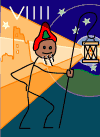Technical info
Format
 The cards are published as SVG, a newish vector-graphics
standard from the W3C. In the fullness of time this will be the
commonly supported format for drawings on-line (as opposed to raster
images, for which PNG and JPEG will remain the standard choice).
In the meantime, you may need to download a plug-in to view SVG
files.
The cards are published as SVG, a newish vector-graphics
standard from the W3C. In the fullness of time this will be the
commonly supported format for drawings on-line (as opposed to raster
images, for which PNG and JPEG will remain the standard choice).
In the meantime, you may need to download a plug-in to view SVG
files.
Why SVG? Because SVGZ is a more compact format for the sorts
of images I am creating even than PNG—and in addition
supports higher resolution, zoom and pan, and interactivity. For
example, the 360-pixel-high PNG of
 The Pope is
14237 bytes; the compressed SVG version is 8725 bytes
and includes the title and keywords,
and you can zoom in see a tiny stick man I included as a joke.
The Pope is
14237 bytes; the compressed SVG version is 8725 bytes
and includes the title and keywords,
and you can zoom in see a tiny stick man I included as a joke.
The pips cards (like the
 Six of Coins) exploit
the intrinsic animation features of the SVG format (SMIL
Animation). When you click on the button at the bottom of the card,
the ‘interpretation’ (an illustration, and the title of
the card) is made visible. Clicking it again hides the
interpretation, leaving just the pips. I did this so that
I could indulge my preference for unadorned pips cards, while not
disappointing people who like their minor arcana to be illustrated!
Six of Coins) exploit
the intrinsic animation features of the SVG format (SMIL
Animation). When you click on the button at the bottom of the card,
the ‘interpretation’ (an illustration, and the title of
the card) is made visible. Clicking it again hides the
interpretation, leaving just the pips. I did this so that
I could indulge my preference for unadorned pips cards, while not
disappointing people who like their minor arcana to be illustrated!
What’s more, the scalable resolution means that when you print the page, the SVG graphics print at the resolution of the printer, not the resolution of your screen (as is the case with PNG or JPEG graphics on a web page).
Availability
 A the time
of writing, the easiest way to view SVG files if you are using
Netscape Navigator, Microsoft Internet Explorer, or Mozilla 0.9.x (on Linux)
is
Adobe’s
SVG Viewer plug-in. I recommend
version 3.0, although I have reports that my graphics also work
in version 2.0.
A the time
of writing, the easiest way to view SVG files if you are using
Netscape Navigator, Microsoft Internet Explorer, or Mozilla 0.9.x (on Linux)
is
Adobe’s
SVG Viewer plug-in. I recommend
version 3.0, although I have reports that my graphics also work
in version 2.0.
Note that, alas! SVG Viewer 3.0 is not compatible with Mozilla 1.0 because of a change to the plug-in architecture of the 0.9.x series that was introduced when the API was frozen for 1.0 (Bugzilla 133567, 115528 ), and Mozilla’s built-in SVG support is not ready for serious use (85803, 111152, 111317, 157514, ...).
Another option is
Batik,
the Java-based SVG tool kit being developed by the
Apache Project.
Batik 1.1.1 includes a simple interactive viewer for SVG
files (amongst other things).
I hear the upcoming version 1.5
includes support for scripting and animation.
To use it to view the tarot cards on this site,
visit http://www.alleged.org.uk/pdc/tarot/wands.svg.
This has links to SVG pages for the other suits
and for trumps.
These are the options I have tried out myself, or friends have told me work for them. There are other SVG viewing options listed on the W3C’s site.
Changes
 As of 5 March 2002,
I have removed the ‘simple’ versions of the
cards This is because I have run out of space on the site. If
you were in fact relying on the ‘simple’ files, then
please let me know and I’ll see if anything can be done.
Also, the SVG files are stored as compressed SVG
(
As of 5 March 2002,
I have removed the ‘simple’ versions of the
cards This is because I have run out of space on the site. If
you were in fact relying on the ‘simple’ files, then
please let me know and I’ll see if anything can be done.
Also, the SVG files are stored as compressed SVG
(.svg), a convention understood by Adobe’s viewer,
and, I hope, other viewers.
Given this reduces the disc space required typically from 69 K to 16 K, this is a reduction I cannot ignore.